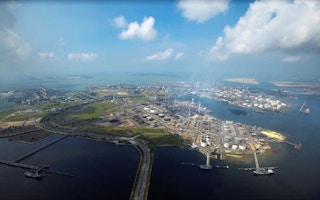Carbon capture, use and storage (CCUS) technology may be expensive and unproven at scale – but there isn’t nearly enough of it being deployed to effectively fight climate change.
To continue reading, subscribe to Eco‑Business.
There's something for everyone. We offer a range of subscription plans.
- Access our stories and receive our Insights Weekly newsletter with the free EB Member plan.
- Unlock unlimited access to our content and archive with EB Circle.
- Publish your content with EB Premium.
Research by consulting firm McKinsey estimates that adoption of CCUS technology needs to grow 120 times by 2050 for the world to meet a mid-century net-zero emissions target to avoid dangerous global warming.
CCUS technology sucks up carbon dioxide before it can fizzle into the atmosphere, then stores it underground or reuses it to make new products.
The need for carbon removal is “unavoidable” if the world is to meet global temperature targets, according to an April report by the United Nations’ Intergovernmental Panel on Climate Change.
McKinsey estimates that it will cost US$130 billion a year to install the amount of CCUS infrastructure needed to meet climate goals – not much less than the budget required to install the electric vehicle charging stations needed to decarbonise road transport by 2050 (US$140 billion a year).
“
CCUS is still seen by many as a waste-disposal service for CO2. But it could be a potential feedstock for everything from cement and building aggregates to polyurethane foams and plastics.
Luciano Di Fiori, partner, McKinsey
Based on the current pipeline of CCUS projects globally, 110 million tonnes per year (MTPA) of CO₂ is expected to be captured annually by 2030. But to achieve the net-zero commitments made by 64 governments at last year’s COP26 climate talks, 715 MTPA are required by 2030 and 4,200 MTPA by 2050, the report noted.
Barriers to scale
Though there are numerous types of carbon-sucking technology under development, the most urgently needed in the short term is industrial-point-source CCUS, which removes carbon from factories, steelworks and other major sources of atmospheric pollution.
Unlike other forms of CCUS – such as direct air capture, which vacuums carbon directly out of the air – industrial-point-source CCUS technology is relatively well-tested and has the potential to trap huge quanties of carbon from hard-to-abate sources, such as coal-fired power stations and cement manufacturers.
But the technology faces challenges to scale. A study of hundreds of carbon capture projects between 1995 and 2018 found that most have been canceled or put on hold. “Every CCUS project to date has been unique, creating all the delivery challenges of first-of-a-kind projects, but they are also commercially fragile, making success all the harder to achieve,” the report said.
As industrial emissions sources are widely distributed, capital will need to be deployed across a huge number of projects all over the world if there’s a chance of capping global warming at safe levels.
Scaling CCUS is also made difficult by a muddled policy approach from governments, which has meant that making the business case for CCUS tricky for the private sector, the report noted. “Companies have been willing to develop plans but are hesitant to commit capital without regulatory certainty, which has led to cautious approaches to spending on project development beyond feasibility studies.”
How to get countries to suck carbon up
Luciano Di Fiori, a partner at McKinsey, said governments will need to create the right tax and legislative frameworks to incentivise private investment in CCUS, and industry must develop new business models for using captured carbon, for instance selling it as feedstock for building material, rather than relying on state subsidies.
In January, SpaceX and Tesla CEO Elon Musk unveiled a plan to use captured carbon as rocket fuel, although critics pointed out that re-releasing trapped carbon into the atmosphere by burning it achieves little in the fight against climate change.
Oil major Exxon Mobil is working on a plan to build a network of CCUS networks across Southeast Asia, while in Singapore a consortium involving energy giant Chevron, cement firm Pan United and computing infrastructure company Keppel Data Centres aims to introduce carbon-trapping tech for the energy, construction, chemicals and IT sectors within the next five to 10 years.
The report noted two other ways to accelerate the business viability of building more CCUS infrastructure. First, to bring down the costs, cross-sector clusters like the planned project in Singapore need to be formed to share large infrastructure like pipeline networks. Second, more efforts should be spent to convince consumers that forking out for emissions-free products is worth the expected premium.
Still, despite the urgent need for investments into CCUS technologies, the reality is that it is still not a highly attractive business proposition in Southeast Asia. A report by energy think tank Institute for Energy Economics and Financial Analysis, released in April, predicted that CCUS technology would flop in in the region, because it is too expensive and there is a lack of carbon pricing mechanisms to make it economically viable.
Others believe that a region predicted to see power sector emissions more than double by 2040 must find a way to make CCUS work. Adam Baylin-Stern, an energy analyst at the International Energy Agency, told Eco-Business last year that without CCUS in Southeast Asia, meeting global climate goals would be “virtually impossible”.










